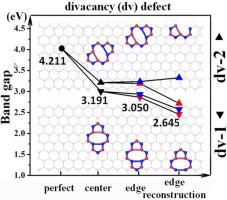A first-principles investigation on the effect of the divacancy defect on the band structures of boron nitride (BN) nanoribbons |
| |
| Affiliation: | 1. Laboratoire des Interfaces et des Matériaux avancés (LIMA), Tunisia;2. Laboratoire de Micro-Optoélectronique et Nanostructures (LMON), Tunisia;3. Unité de Recherche sur les Hétéro-Epitaxies et Applications (URHEA), Tunisia;4. Université Monastir, Faculté des Sciences de Monastir, Département de Physique, Avenue de l’environnement, 5019 Monastir, Tunisia;1. School of Electrical Engineering, Xi’an Aeronautical University, Xi’an 710077, China;2. Shaanxi Key Laboratory of Industrial Automation, Shaanxi University of Technology, Hanzhong 723001, China |
| |
| Abstract: | 
On the basis of the comprehensive first-principles computations, we investigated the geometries, electronic and magnetic properties of zigzag and armchair boron nitride nanoribbons (BNNRs) with the divacancy defect of 5–8–5 ring fusions formed by removing B–N pair, where the defect orientation and position are considered. Our computed results reveal that all of the defective BNNRs systems can uniformly exhibit nonmagnetic semiconducting behavior, and the formation of the divacancy 5–8–5 defect can significantly impact the band structures of BNNRs with not only the zigzag but also armchair edges, where their wide band gaps are reduced and the defect orientation and position play an important role. Clearly, introducing divacancy defect can be a promising and effective approach to engineer the band structures of BNNRs, and the present computed results can provide some valuable insights for promoting the practical applications of excellent BN-based nanomaterials in the nanodevices. |
| |
| Keywords: | Boron nitride nanoribbons First-principles computation Band structure Divacancy defect (5–8–5) |
| 本文献已被 ScienceDirect 等数据库收录! |
|

